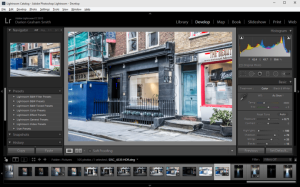

The more I brush over certain areas, the more opaque the red will appear. I will also add some of the foreground to the burn area to make the bright areas stand out. I’ll bring down the exposure slider a bit, and repeat the same process to darken the area around the rocks. Select Brush, and New Mask will appear in your Mask window. Now, if we wanted to burn the image (darkening some areas) we’d just create a new mask by clicking the Create New Mask in the Mask window. Looking at the images side-by-side, the change is so subtle that nothing looks strange or out of the norm. I also dodged the mountain tops a bit to make them pop. The result is that the exposure of the rocks is increased, effectively highlighting them, but the result looks natural and blends seamlessly with the rest of the image.

Here there are some faint adjustments visible on the rocks.īut when I go over certain areas a few times, you’ll notice the red area becomes denser. Again, this red highlight represents the adjustment area. You’ll just barely notice the slight red tint in that area, representing the adjustment brush strokes. So, I’ll go in with an initial couple of strokes over the entire area - make sure you’ve checked Show Overlay in the Mask window, and you can select the color of the overlay by clicking the box on the right, or you can leave it red. In this example, I want to dodge (brighten) the rocks to draw more attention to them. That way the adjustment blends seamlessly with the rest of your image. This will ensure the initial brush strokes you make will be so soft they are barely noticeable but allow you to build them up by painting over the same area multiple times. These adjustments control the output of your brush, along with the transparency of each brush stroke. You’ll then want to put the Flow and Density at 50%. I suggest keeping this as high as possible to ensure the dodged or burned area blends seamlessly with the rest of the image. Feather refers to how hard or soft the brush edge will be. You can increase or decrease the size of your brush based on the area you’re working with. These will affect how the brush strokes are applied to your image. To burn, slide to the left to decrease exposure (you can come back to this slider later to adjust the brightness further).īut first, let’s adjust the brush itself by heading to the brush settings at the top. To dodge, slide to the right to increase the exposure slightly. To dodge and burn, we’ll utilize the Exposure slider. In the panel on the right, you’ll see all the different adjustments you can make - everything from exposure and color to sharpness and effects. You’ll notice the Mask window appears to help you keep track of the different masks you’ll add to your image. This will bring you to the Adjustment Brush, which allows you to paint adjustments onto your image. Select Brush from the different available masks. To dodge and burn in Lightroom Classic, open your image and head to the Develop tab.īetween the Histogram and the Basic tabs on the right, you’ll see a bar with some extra icons. The goal of these adjustments is to enhance details or draw the viewer’s attention to certain parts of the image by adding brightening and darkening adjustments there. To start things off, let’s get into Lightroom Classic. This can be done in both Lightroom Classic and Lightroom CC using the masking tools - and it’s quite a simple process. If you’re not sure how to adjust the brush settings or don’t know exactly what exposure setting to use, we will get into all the details here. With your brush settings correct, paint over the image to dodge and burn.

Set the brush flow and opacity between 25% – 50% and adjust the exposure slider to either darken (burn) or lighten (dodge). To dodge and burn in Lightroom, click the Mask adjustment and choose the adjustment brush. Dodging and burning has long been thought of as something to be done in Photoshop, but there are a few easy ways to get dodge and burn effects in Lightroom too. By applying subtle darkening or brightening adjustments, you can add life to a photo and draw your viewer’s eye to the subject. Dodging and burning is one of the most useful edits to enhance a photo in Lightroom.


 0 kommentar(er)
0 kommentar(er)
